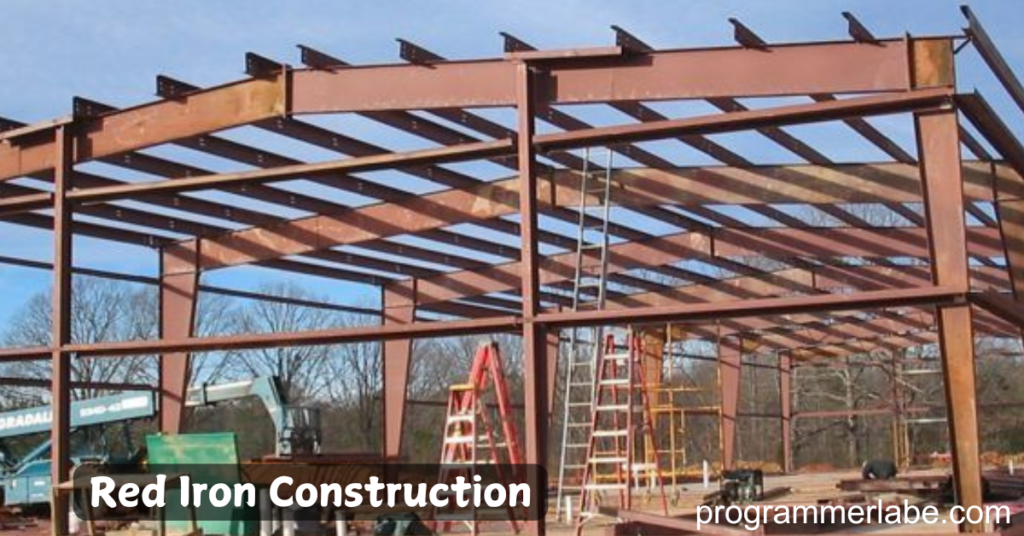In the ever-evolving world of construction, red iron, or red-painted steel, has emerged as a prominent choice for builders and architects seeking a balance of strength, durability, and aesthetic appeal. Red iron construction offers numerous advantages that make it a valuable material in modern building projects. From its robust structural capabilities to its versatile design applications, red iron is a cornerstone in contemporary construction.
This article explores the durability, design aspects, and benefits of red iron construction.
Understanding Red Iron Construction
Red iron refers to structural steel that is often coated with a red primer or paint to protect it from corrosion. The term “red iron” is commonly used in the construction industry to denote this specific type of steel framework. Red iron steel is made from iron alloyed with other elements to enhance its strength and durability, making it ideal for use in various building applications.
Durability of Red Iron Construction
One of the primary reasons red iron is favored in construction is its exceptional durability. Steel, as a material, possesses inherent properties that contribute to its strength and resilience:
- Corrosion Resistance: The red paint or primer applied to red iron steel serves as a protective barrier against moisture, chemicals, and other environmental factors that can cause rust and corrosion. This coating helps to extend the lifespan of the steel and maintain its structural integrity over time.
- High Strength-to-Weight Ratio: Red iron steel has a high strength-to-weight ratio, which means it can support significant loads without being excessively heavy. This characteristic makes it suitable for large-scale construction projects, such as skyscrapers, bridges, and industrial buildings, where both strength and weight considerations are critical.
- Fire Resistance: Steel has excellent fire resistance properties. When exposed to high temperatures, red iron steel retains its structural integrity longer than many other materials. This fire resistance is enhanced by the protective coating, which can provide additional insulation against heat.
Design Flexibility and Aesthetic Appeal
Red iron construction not only excels in durability but also offers significant design flexibility and aesthetic appeal:
- Versatile Applications: Red iron steel can be used in a wide range of applications, from residential and commercial buildings to industrial structures and infrastructure projects. Its versatility allows architects and builders to incorporate red iron into various design styles and structural requirements.
- Architectural Flexibility: Red iron steel can be fabricated into different shapes and sizes, allowing for creative and innovative architectural designs. The material can be used to create complex geometries, open spaces, and distinctive structural features that enhance the overall aesthetic of a building.
- Modern Industrial Look: The red-painted finish of red iron steel contributes to a modern, industrial look that is highly sought after in contemporary architecture. This aesthetic appeal is often utilized in buildings where a rugged, raw appearance is desired, such as lofts, warehouses, and urban commercial spaces.
Sustainability and Environmental Benefits
Red iron construction also aligns with sustainability goals and offers several environmental benefits:
- Recyclability: Steel is one of the most recyclable materials in the construction industry. Red iron steel can be recycled at the end of its life cycle, reducing waste and minimizing the environmental impact of construction projects.
- Energy Efficiency: The durability and longevity of red iron construction contribute to energy efficiency over the lifespan of a building. The reduced need for repairs and maintenance helps to lower the overall energy consumption associated with maintaining the structure.
- Reduced Environmental Impact: The use of red iron steel in construction can help reduce the environmental footprint of building projects. Its durability means that fewer resources are needed for repairs and replacements, and its recyclability contributes to a circular economy.
Challenges and Considerations
While red iron construction offers numerous benefits, there are some challenges and considerations to be aware of:
- Initial Cost: The initial cost of red iron steel can be higher compared to other materials. However, this cost is often offset by the material’s long-term durability and low maintenance requirements.
- Thermal Conductivity: Steel has high thermal conductivity, which means it can transfer heat more readily than some other materials. This characteristic may require additional insulation measures to ensure energy efficiency and comfort within the building.
- Installation Expertise: Proper installation of red iron construction requires specialized knowledge and expertise. Builders and contractors must be skilled in handling and assembling steel frameworks to ensure structural stability and safety.
Conclusion
Red iron construction represents a powerful combination of durability, design flexibility, and aesthetic appeal. Its robust properties make it a reliable choice for various building applications, from residential and commercial projects to large-scale industrial structures. The versatility of red iron steel, coupled with its modern industrial look, allows for innovative architectural designs and creative use in contemporary construction.
